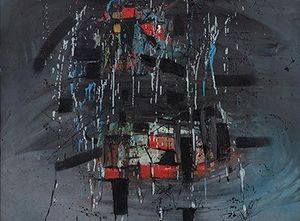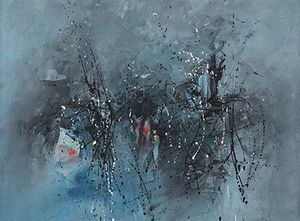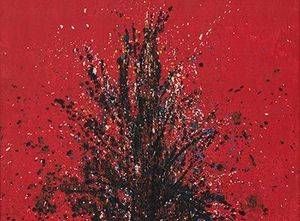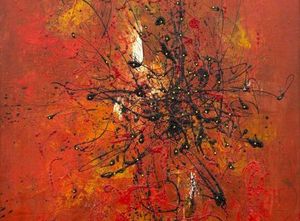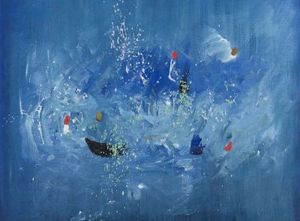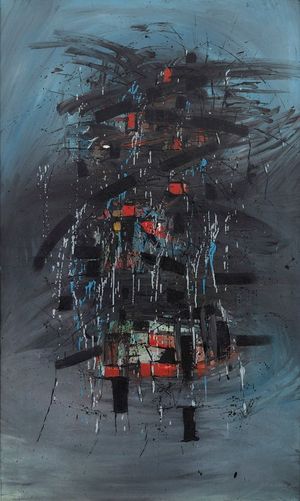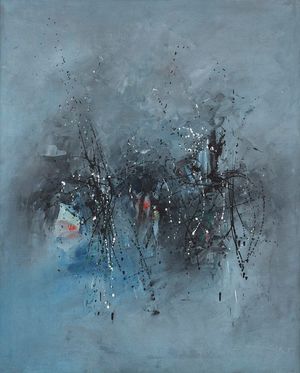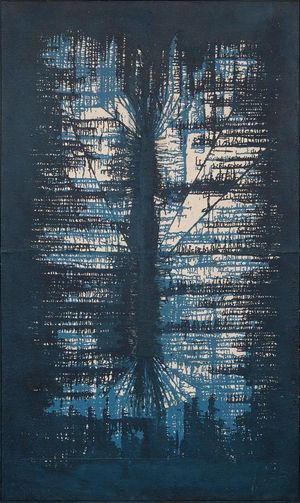Antonio Bandeira was a pioneer of lyrical abstraction in Brazil. His free, gestural painting achieved prominence in the 1950s. In 1952, he exhibited at the 26th Venice Biennale, and by the 1960s he was already an established artist, one of the most valued Brazilian painters inside and outside the country. A unique artist, he was actively involved in the aesthetic debates of his time, producing watercolors, gouaches and paintings marked by intense chromatic and poetic research. Antonio Bandeira's life is shrouded in myths and narratives, instigated by the artist himself, who built his persona as a bohemian, a character who moved with the same ease in bars, in high culture spaces and in the circles of the Parisian artistic avant-garde.
His career began in 1941, in Fortaleza, when he exhibited for the first time at the Salão Cearense de Pintura. Still in the early 1940s, he actively participated in the creation of the Centro Cultural de Belas Artes, a meeting place for a young generation of artists from Ceará, which also brought together established names such as Raimundo Cela. The capital was going through a period of modernist artistic effervescence, with the Swiss cultural agitator Jean Pierre Chabloz and the young artists Aldemir Martins, Inimá de Paula, Mario Baratta and Antonio Bandeira standing out.
In 1946, influenced by Chabloz, Bandeira went to Rio de Janeiro, where he held his first solo exhibition at the Institute of Architects. That same year, he made his first trip abroad. A prodigy artist, at just 24 years old and self-taught, he was awarded a scholarship to study in Paris, at the École Nationale Supérieure des Beaux-Arts and the Académie de La Grande Chaumière. This period had a decisive influence on the development of his pictorial language, due to his close contact with the discussions surrounding a new language: informal or "lyrical" abstractionism. Throughout his intense career, Bandeira took part in international exhibitions in France, Germany, Italy, England and the United States. Back in Brazil in 1951, he took part in the 1st Bienal de São Paulo and exhibited continuously in museums and salons. In 1964, he returned permanently to Paris, remaining until his death three years later.
Despite the influence of French art, his approach to international trends in abstract painting was not unrelated to a strong commitment to his own experience. Recognized for its lyricism and experimentation with color, Bandeira's painting takes unexpected paths within abstractionism. Subtle or dense, the stains, lines and weaves that make up his canvases actually represent landscapes, trees, cities, and often evoke atmospheres and memories of his homeland. This correspondence is explicit not only in his statements but also in the titles of his works, which indicate these interpretative paths. If the artist's gesture is not motivated by the goal of representation, he soon finds figuration again, through the free association between the different elements present in his paintings.
Currently, Antonio Bandeira's works are part of the Brazillian´s main private collections and are present in the collections of various public institutions, including Centre Pompidou, Paris; Museu de Arte de São Paulo Assis Chateaubriand, MASP, São Paulo; Museu de Arte da Universidade Federal do Ceará, Fortaleza; Museu de Arte Moderna do Rio de Janeiro, MAM Rio; Museu de Arte Moderna de São Paulo, MAM SP; Museu Nacional de Belas Artes, Rio de Janeiro; Embaixada do Brasil, Paris; Museus Castro Maya, Rio de Janeiro; Museu de Arte Contemporânea da Universidade de São Paulo, MAC USP, among others.


